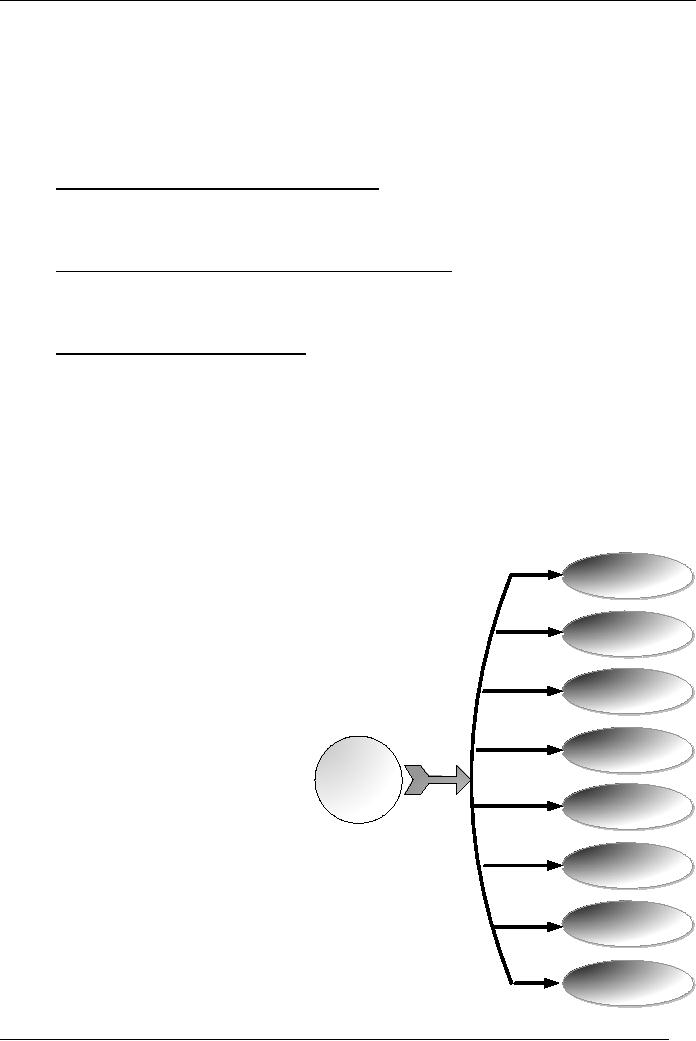 |

Brand
Management (MKT624)
VU
Lesson
37
PRICING
Introduction
We
move on to the next learning
block of pricing. The
lecture discusses the
concept for
developing
premium pricing for your
brand. The considerations
that lay the ground
for
developing
such a model are a part of
the lecture.
Pricing
Once
you have determined the
positioning of your brand,
developed brand architecture,
and
have
plans in place to leverage it through
the right channels and
communication, the next
most
important
task is the determination of pricing.
Pricing has to be done keeping in
mind that your
brand
is an asset that is going to
provide you with the
right contribution to enable you
achieve
all
your financial goals.
Raising
or lowering the price point
makes the difference between
high or low
contribution
margins.
Pricing, in other words,
determines the level of
value that it adds to the
company.
The
ideal situation is that we
try to command a premium
price in relation to competition,
but
idealistic
set of circumstances is not
what always prevails in the
market. We, therefore, have
to
take
a realistic look at all the
determinants of our brand
architecture strategy in the
light of
forces
that define the
market.
Strong
umbrella lets you charge
premium
If
you are stretching a strong,
powerful brand or following
umbrella strategy to gain
the
benefits
of a strong brand, then you
should be all set to go for
a premium price.
Source/endorsing
brand strategy also helps
premium
Similarly,
if you are introducing a new
brand under the source brand
or endorsing brand
strategy
to gain the benefits of
brand power, you again are
in a position to charge a premium
price.
The
question is what if you are
a new company offering a new
brand? It may be difficult to go
for
a premium pricing. However, it is
not impossible. You may
co-brand and go for a decent
price
point, if not
premium.
There
are so many different
pricing models, but let's
concentrate on the premium
price model
and
see under what conditions it
works best? Some of the
following conditions offer a
good
ground
for brands to stand on and enjoy the
benefits of premium
pricing1:
�
The
stronger the brand, the
greater the potential to charge a premium
price. Customers
are
always willing to spend more
on a brand that is well established and
commands
power.
�
A
strong extension (line or
brand) sets the stage
for a launch that is less
expensive and,
hence,
offers you a platform from
where you can extract better
margins. This is a
case
of
lower costs!
�
By
the same token, you can
recover development and launch
costs sooner if your
introduction
is endorsed by a strong brand.
Customers are willing to try
a new product
under
a familiar brand name than a
new one. This also entails
lower costs!
�
The
larger the base of loyal
customers, the greater the
chances that those customers
will
pay
a premium price. That is why
managers work so hard to
retain their customers
over
time.
The longer customers stick
to one brand, the more they
are willing to pay,
thus
enhancing
value of the brand.
146

Brand
Management (MKT624)
VU
�
A
strong brand allows all
the members of the channel to make
more money and make it
fast.
It, therefore offers you the
leadership role and you
control the channel.
�
A
strong brand offers
opportunities like licensing,
franchising, and co-branding.
Capitalized
strategically, these offer companies
value in financial as well as
market
terms.
Three
facts about strong brands
We
can figure out three facts
from the above
conditions:
1.
Brand strength, pricing, and
costs are related
Brand
strength, pricing, and costs
have such a relationship
that their combination
allows
you
to have a healthy bottom
line either through charging
a premium price or
through
lowering
costs.
2.
Strong brands offer added
benefits and hence premium
Another
fact that is clear is that
strong brands are superior
products that offer you
added
benefits.
If you happen to be at the top of
the value pyramid, there is
nothing stopping
you
from charging a premium
price.
3.
Brand loyalty brings you
premium
Similarly,
it becomes obvious that
loyalty and premium pricing
are also related.
Maintaining
brand loyalty, therefore, is one of
the prime jobs of brand
managers who
must
know what are the
drivers of brand
loyalty?
Factors
that drive
loyalty
General
observations of marketing managers
are substantiated by research findings
that show
us
that the factors that
really drive loyalty carry
weight in the order they
are shown as
grtaphics2.
Drivers
of Loyalty
Figure
42
The
order
is
significant,
and
convincingly
reflects the fact that it
is
not
the price that a company
should
Quality
focus
on; it is the benefits that
must get
concentration
of managers. The more a
company
can generate the drivers on
top
Dependability
of
the list, the better
chances it has to
charge
a premium.
Association
The
concept of value pyramid is
getting
a
testimony for credibility
here. The
need
to be consistent all along
the road
Value
for money
from
brand picture to contract
to
Drivers
positioning
to brand architecture and
In
order of
weight
communication
cannot be emphasized
Fits
personality
anywhere
more than here at the
price
juncture.
The
pricing, in other words, has
to be
Solves
problem
consistent
with product
development
strategy.
Rest will fall in place. A good
Good
customer
product
that can offer customers
the
service
benefits
illustrated
graphically,
preferably
in the order shown has a
great
Environmentally
chance
to demand a premium pricing.
friendly
This
applies to all brands, tangible
147

Brand
Management (MKT624)
VU
products
and services, regardless of the
category.
We
have seen how a premium
pricing model works, but
then not all situations
are conducive to
charging
a premium pricing. What then
is the right model? We shall
discuss that in the
next
lecture.
Summary
The
discussion makes one strong
point that in order for a
brand to command a premium
price
or
a level of decent price, it has to make
itself strong. Brand
managers should consider
brand
architecture
both from the multiple
standpoints of market acceptance,
lower costs, and better
pricing.
The stronger the brand,
the better the price it
commands.
Brand
loyalty is the strongest
ingredient of premium price.
Customers tend to accept
premium
pricing
if they are loyal toward a
brand. Loyalty is a function of so
many factors that
consumers
have
rated in order of preference. Going by
that it becomes clear that
managers should work
to
strengthen
those factors and good pricing will fall
in place.
Bibliography:
1.
Scot M. Davis: "Brand Asset
Management Driving Profitable
Growth through
Your
Brand";
Jossey-Bass, a Wiley Imprint
(200-202)
2.
Scot M. Davis: "Brand Asset
Management Driving Profitable
Growth through
Your
Brand";
Jossey-Bass, a Wiley Imprint
(206-207)
Suggested
Readings:
1.
Scot M. Davis: "Brand Asset
Management Driving Profitable
Growth through
Your
Brand";
Jossey-Bass, a Wiley Imprint
(199-207)
148
Table of Contents:
- UNDERSTANDING BRANDS – INTRODUCTION:Functions of Brand Management, Sales forecast, Brand plan
- INTRODUCTION:Brand Value and Power, Generate Profits and Build Brand Equity
- BRAND MANIFESTATIONS/ FUNDAMENTALS:Brand identity, Communication, Differentiation
- BRAND MANIFESTATIONS/ FUNDAMENTALS:Layers/levels of brands, Commitment of top management
- BRAND CHALLENGES:Consumer Revolt, Media Cost and Fragmentation, Vision
- STRATEGIC BRAND MANAGEMENT:Setting Objectives, Crafting a Strategy, The Brand Mission
- BRAND VISION:Consensus among management, Vision Statement of a Fast Food Company, Glossary of terms
- BUILDING BRAND VISION:Seek senior management’s input, Determine the financial contribution gap
- BUILDING BRAND VISION:Collect industry data and create a brand vision starter, BRAND PICTURE,
- BRAND PICTURE:Brand Value Pyramid, Importance of being at pinnacle, From pinnacle to bottom
- BRAND PERSONA:Need-based segmentation research, Personality traits through research
- BRAND CONTRACT:The need to stay contemporary, Summary
- BRAND CONTRACT:How to create a brand contract?, Brand contract principles, Understand customers’ perspective
- BRAND CONTRACT:Translate into standards, Fulfill Good Promises, Uncover Bad Promises
- BRAND BASED CUSTOMER MODEL:Identify your competitors, Compare your brand with competition
- BRAND BASED CUSTOMER MODEL:POSITIONING, Product era, Image Era, An important factor
- POSITIONING:Strong Positioning, Understanding of components through an example
- POSITIONING:Clarity about target market, Clarity about point of difference
- POSITIONING – GUIDING PRINCIPLES:Uniqueness, Credibility, Fit
- POSITIONING – GUIDING PRINCIPLES:Communicating the actual positioning, Evaluation criteria, Coining the message
- BRAND EXTENSION:Leveraging, Leveraging, Line Extension in detail, Positive side of line extension
- LINE EXTENSION:Reaction to negative side of extensions, Immediate actions for better managing line extensions
- BRAND EXTENSION/ DIVERSIFICATION:Why extend/diversify the brand,
- POSITIONING – THE BASE OF EXTENSION:Extending your target market, Consistency with brand vision
- DEVELOPING THE MODEL OF BRAND EXTENSION:Limitations, Multi-brand portfolio, The question of portfolio size
- BRAND PORTFOLIO:Segment variance, Constraints, Developing the model – multi-brand portfolio
- BRAND ARCHITECTURE:Branding strategies, Drawbacks of the product brand strategy, The umbrella brand strategy
- BRAND ARCHITECTURE:Source brand strategy, Endorsing brand strategy, What strategy to choose?
- CHANNELS OF DISTRIBUTION:Components of channel performance, Value thru product benefits
- CREATING VALUE:Value thru cost-efficiency, Members’ relationship with brand, Power defined
- CO BRANDING:Bundling, Forms of communications, Advertising and Promotions
- CUSTOMER RESPONSE HIERARCHY:Brand-based strategy, Methods of appropriations
- ADVERTISING:Developing advertising, Major responsibilities
- ADVERTISING:Message Frequency and Customer Awareness, Message Reinforcement
- SALES PROMOTIONS:Involvement of sales staff, Effects of promotions, Duration should be short
- OTHER COMMUNICATION TOOLS:Public relations, Event marketing, Foundations of one-to-one relationship
- PRICING:Strong umbrella lets you charge premium, Factors that drive loyalty
- PRICING:Market-based pricing, Cost-based pricing
- RETURN ON BRAND INVESTMENT – ROBI:Brand dynamics, On the relevance dimension
- BRAND DYNAMICS:On the dimension of knowledge, The importance of measures
- BRAND – BASED ORGANIZATION:Benefits, Not just marketing but whole culture, Tools to effective communication
- SERVICE BRANDS:The difference, Hard side of service selling, Solutions
- BRAND PLANNING:Corporate strategy and brands, Brand chartering, Brand planning process
- BRAND PLANNING PROCESS:Driver for change (continued), Brand analysis
- BRAND PLAN:Objectives, Need, Source of volume, Media strategy, Management strategy